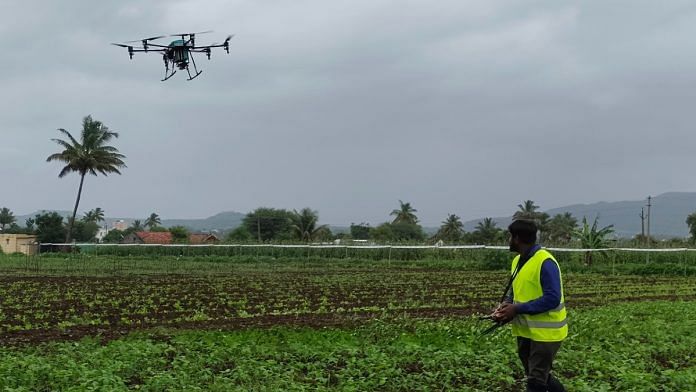Pune: For most farmers, drudgery is a way of life. Susheel Kumar learnt it the hard way. Born in a farmer’s family in rural Haryana, he would often carry heavy sprayers on his back to apply insecticides on rice and wheat crops.
But more than the load, it was the draining summer heat that made spraying an exhausting task, Kumar remembers.
So, it was a special moment when on a rainy Friday morning in July, Kumar flagged off a new technology for Indian farmers: drones.
The flying beast weighing 42 kg can spray with precision, be remotely controlled and finish within minutes those tasks, which a farm worker usually takes hours to complete.
Now 40, Susheel Kumar is the country head and managing director of Syngenta India, a leading manufacturer of agrochemicals and hybrid seeds.
Tomato, capsicum, chili, watermelon and corn seeds produced by Syngenta are widely used by farmers in India. The company is a market leader in vegetable seeds — employees proudly proclaim that every fourth tomato consumed in India is grown from Syngenta seeds.
Syngenta India, headquartered in Pune, Maharashtra, is a subsidiary of Syngenta Global, which has its managing headquarters in Basel, Switzerland, and is registered in Shanghai, China.
In 2017, the state-owned China National Chemical Corporation, also known as ChemChina, acquired Syngenta Global for US$43 billion — the largest foreign acquisition by China which views food and agriculture as strategic sectors.
Syngenta Global is now readying to launch a mega initial public offering at the Shanghai stock exchange by end-2022.
Also Read: Answer to climate shocks? Heat-resistant wheat from ICAR hits markets, ‘grows in 100 days’
Smart farming
Syngenta Global counts India among its focus markets worldwide which include the US, Brazil, Argentina and China.
On 15 July, Susheel Kumar, the India head, and Feroz Sheikh, Syngenta Global’s chief information and digital officer, flagged off an ambitious journey from its Pune headquarters: a 10,000-km roadshow to educate farmers in 13 states by deploying 50 drones.
Syngenta is the first private company to receive an approval from the Central Insecticide Board for drone-spraying of Amistar Plus, a fungicide, and Ampligo, an insecticide. Drone-spraying of these products has been allowed for three crops — rice, cotton and soybean.
The approval was granted after Syngenta India submitted data on safety and bio-efficacy field trials.
The central government has also granted an interim two-year approval for drone-spraying of nearly all registered crop protection chemicals sold to farmers, except herbicides. Of the 477 products approved for drone spraying, 40 formulations are from Syngenta.
But why is a product company like Syngenta spending energy and resources to showcase a tech-driven service like drone-spraying?
“Our objective is to enable farmers… identify their pain points, see what we can do to solve their problems and provide a platform to enable access to new technology,” Kumar told ThePrint during an interaction ahead of the roadshow’s launch.
He pointed to several benefits of drone-spraying — from convenience and efficiency to reducing water use and solving the challenge of timely availability of labour.
“In future, drones can be fitted with cameras for precision application – such as spraying more in areas where pest infestation is higher,” Kumar said.
According to Kumar, the cost of spraying by drones is currently high, ranging from Rs 500 to Rs 600 per spray per acre. That is nearly three times what manual-spraying costs. As the technology evolves and more farmers rent drones for spraying — like they have been doing for harvesters and other expensive farm equipment — costs are expected to reduce sharply.
Also Read: From tomatoes to wheat, Indian crop forecasting is in the grip of a Raja Todar Mal problem
How drones work
Last Friday, a five-acre field trial site of Syngenta in Manchar, about 60 km from Pune city, was the site of frenzied action. Scientists and field staff were readying to demonstrate drone-spraying to farmers from neighbouring villages, nestled in the picturesque foothills of the Sahyadri mountain range.
Braving rains, mud and the slush around, the 42 kg drone was carried to a soybean field. Resting on a pair of landing skids with multiple blades and nozzles fitted underneath, it looked like a venerable machine.
But before the drone could take off, Srikanth Srinivasan from General Aeronautics, a Bengaluru-based startup which developed the drones, had to field queries from the farmers around.
Srinivasan answered patiently. The machine costs about Rs 11 lakh apiece. Its womb contains three lithium-ion batteries and a 16-litre pesticide tank. On a single charge, the drone can fly about two metres above the crop canopy for 45 minutes and complete spraying an acre of land. That compares with back-breaking three-four hours of hard labour to cover the same area.
The batteries can be charged for 600 cycles and the drone can cover more than 3,000 acres in a year.
“Drone-spraying is safer since application of chemicals is targeted and automated. The special nozzle creates a body spray like mist which is evenly spread over and under the leaves, unlike manual sprayers which release chemicals in large droplets,” Srinivasan said.
The entire process is automated. A trained farmer, for instance, can map the field with a GPS device. The drone follows the preset boundaries and does not stray into adjacent areas.
As Srinivasan completed the rapid-fire Q&A session, the drone took off with a whirring sound. Its low flight and swinging movements on the backdrop of cloudy skies and faraway hills made for an arresting sight.
This reporter visited Pune as a guest of Syngenta.
(Edited by Nida Fatima Siddiqui)
Also Read: As drones usher in new era of warfare, India’s growing UAV industry begins to take flight



